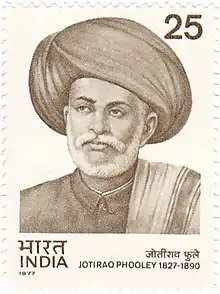Mali caste
The Mali are an occupational caste found among the Hindus who traditionally worked as gardeners and florists. They also call themselves Phul Mali due to their occupation of growing flowers. The Mali are found throughout North India, East India as well as the Terai region of Nepal and Maharashtra.
.jpg.webp)
Mali of Northern India
There are many endogamous groups within Malis. Not all Mali groups have the same origin, culture, history or social standing and there is at least one group - the Rajput Mali, from Rajasthan - that overlaps with Rajputs and was included under the Rajput sub-category in the 1891 State Census Report for Marwar.[1][lower-alpha 1]
Mali caste of Maharashtra

The Mali of Maharashtra are a caste of cultivators specializing in horticulture.[4] The caste is concentrated in five districts of Western Maharashtra and a district in the Vidarbha region.[5] They traditionally made their living by cultivating fruit, flowers and vegetables.[6][7] There are many different sub-castes depending on what the sub-group cultivated, for example, the Phul mali were florists, the Jire mali grew jire or cumin, and halde mali cultivated Halad (turmeric) etc.[8][9] In the 20th century, the mali have been the pioneers in using irrigation to grow cash crops such as sugar cane and in establishing farmer owned sugar mills.[10] This led later in the century of widespread cultivation of sugarcane in Western Maharashtra by other communities as well as the establishment hundreds of sugar mills in Maharashtra and other regions of India.[11][12]
Social activism & politics
The 19th century social reformer, Jyotirao Phule belonged to the Mali community.His work extended to many fields including eradication of untouchability and the caste system, and women's emancipation. He and his wife, Savitribai Phule, were pioneers of education for women and Dalits in India. The couple was among the first native Indians to open a school for girls of India. He also founded a home for pregnant Hindu brahmin widows who were cast out by their families.[13] In 1873, Phule, along with his followers, formed the Satyashodhak Samaj (Society of Seekers of Truth) to attain equal rights for people from lower castes. Other Mali such as Gyanoba Sasane and Narayan lokhande were leading members and financial supporters of the Samaj in its early years.[14] Lokhande has been called the father of trade Unionism in India.[15]
References
Notes
- The census operations of the British Raj were, however, unreliable.
Citations
- Action sociology and development, pp 198, Bindeshwar Pathak, Concept Publishing Company, 1992
- Aggarwal, Partap C (1966). "Problems of Cultural Integration A Muslim Sub-Caste of North India". Economic and Political Weekly. 1 (4): 159–161. JSTOR 4356925.
...the Malis (ie gardners who call themselves Saini now)..
- "At the time of 1941 Census most of them got registered themselves as Saini (Sainik Kshatriya) Malis." pp 7, Census of India, 1961, Volume 14, Issue 5 , Office of the Registrar General, India.
- Gail Omvedt (18 June 1993). Reinventing Revolution: New Social Movements and the Socialist Tradition in India. M.E. Sharpe. p. 336. ISBN 978-0-7656-3176-3.
- Christophe Jaffrelot (Editor); Sanjay Kumar (Editor); Rajendra Vora (Author) (4 May 2012). Rise of the Plebeians?: The Changing Face of the Indian Legislative Assemblies. Routledge. p. 217. ISBN 978-1-136-51662-7.CS1 maint: extra text: authors list (link)
- Dr. S. L. PATIL. EXPORT OF IMPORTANT FRUIT CROPS OF MAHARASHTRA Volume-I. Lulu.com. p. 5. ISBN 978-1-365-92369-2.
- Rosalind O'Hanlon (22 August 2002). Caste, Conflict and Ideology: Mahatma Jotirao Phule and Low Caste Protest in Nineteenth-Century Western India. Cambridge University Press. p. 105. ISBN 978-0-521-52308-0.
- Govind Sadashiv Ghurye (1969). Caste and Race in India. Popular Prakashan. p. 38. ISBN 978-81-7154-205-5.
- Maxine Berntsen (1 January 1988). The Experience of Hinduism: Essays on Religion in Maharashtra. SUNY Press. p. 343. ISBN 978-0-88706-662-7.
- Lalwani, Mala (2008). "Sugar Co-operatives in Maharashtra: A Political Economy Perspective" (PDF). The Journal of Development Studies. 44 (10): 1474–1505. Archived from the original (PDF) on 17 January 2014.
- Attwood, D.W., 2010. How I Learned To Do Incorrect Research. Economic and Political Weekly, pp.37-44.
- Donald W. Attwood; D W Attwood (16 September 2019). "The Bombay Deccan: Cane & Gul production". Raising Cane: The Political Economy Of Sugar In Western India. Taylor & Francis. ISBN 978-1-00-030891-4.
- O'Hanlon2002, p. 135.
- Bhadru, G. (2002). "Contribution of Satyashodhak Samaj to the Low Caste Protest Movement in 19th Century". Proceedings of the Indian History Congress. 63: 845–854. JSTOR 44158153.
- Pandit, Nalini (1997). "Narayan Meghaji Lokhande: The Father of Trade Union Movement in India". Economic and Political Weekly. 32 (7): 327–329. JSTOR 4405089.
Bibliography
| Wikimedia Commons has media related to Mali caste. |